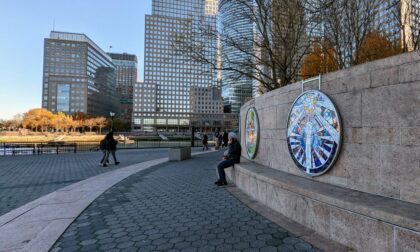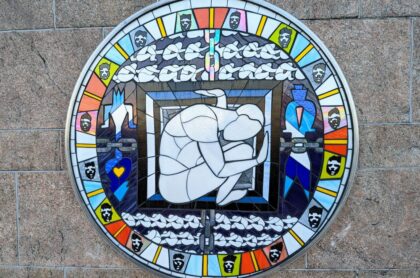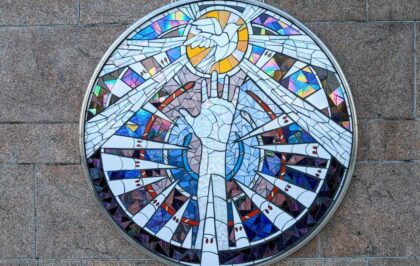Art in Tribeca: James Hough’s “Justice Reflected”
The Battery Park City Authority has installed three stained glass panels by formerly incarcerated artist James Yaya Hough at Esplanade Plaza, just south of the marina. The work will be up for the next year.
The installation uses glass compositions to depict the experiences of incarcerated people, evoking feelings of isolation, despair, fear and hope. Hough was sentenced to life without parole at age 17 for murder. He served 27 years.
The 5-foot circular medallions are in the style of stained-glass windows, mounted on the granite wall facing west. Hough selected the location for its openness and accessibility.
This from a profile of Hough from Art Forum, published in 2021:
AT THE AGE OF SEVENTEEN, James “Yaya” Hough was sentenced to life without parole in Pennsylvania, a state responsible for sentencing more Black youth to life than almost any other. Told that he would never be released from prison, he turned that death sentence into a rigorous reading and art practice, spending hours a day with his sketchbooks drawing, painting watercolors, and working on communal murals inside the facility. He describes his daily routine as taking on a spiritual character, a “discipline,” but not in any punitive sense. He was known and admired inside prison for his pen drawings and watercolors on the back of pink prison documents, carbon paper, and other carceral forms. He became a mentor to other incarcerated artists, including Russell Craig, who first told me about Hough in 2017. Hough told Craig “to be undeniable,” a phrase he and Craig repeat often.
Hough was released from State Correctional Institution Phoenix in August 2019, almost twenty-seven years into his sentence, in large part due to a Supreme Court ruling that mandatory life without parole for juveniles is unconstitutional. Within weeks of his release, Hough became the inaugural artist in residence for the district attorney’s office of Philadelphia, working on several high-profile projects with Mural Arts Philadelphia, an established nonprofit known for collaborating with system-impacted people to transform public space. Last fall, he made his museum debut in MoMA PS1’s “Marking Time: Art in the Age of Mass Incarceration.”
















“On Aug. 19, 1992, the world changed forever for James Hough. Two bullets was all it took to end the life of 39-year-old Ronald Davis, and Hough was responsible.
“Davis was unarmed, standing on a street corner in Pittsburgh’s Beltzhoover neighborhood when Hough and a group of friends approached Davis and knocked him to the ground before Hough killed him.
“Hough was only 17 at the time.”
https://duqjma2017.wixsite.com/juvenilejustice/james-hough-1
Another version:
“The relevant facts and procedural history of this case are as follows. In 1992, when he was seventeen years old, Appellant was drinking and carousing with a group of fifty teenagers on a street corner in Pittsburgh. The intoxicated victim, a 39-year-old man unaffiliated with the teens, approached one of Appellant’s friends and asked if he wanted to smoke some crack cocaine. Appellant felt ‘disrespected’ by the comment, and some of the other teenagers began hitting and kicking the victim, who attempted to flee. […] Appellant pulled out a gun and shot the victim, who later died from his wounds.”
https://www.courtlistener.com/opinion/4552352/com-v-hough-j/
But sure, lets celebrate this guy. What planet are we living on?
“People can change for the better—lives can’t be replaced, but they can be redeemed; in order for society to heal we need that.”
– James Hough in a letter to the Lifelines Project on July 31, 2015.